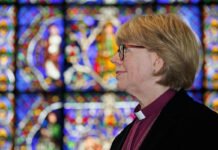In a press release dated 18 December 2020, St Helen’s Bishopsgate announced that they are now in “a state of broken partnership” with their bishop and diocese. It’s easy to sympathise with the predicament in which St Helen’s, like other orthodox Church of England parishes, find themselves. But it’s hard to view their action as coherent. And harder still to think of it as a wise model for others to emulate.
In assessing the decision, it’s important to recognise the influence St Helen’s has over a certain sector of English Anglicanism. By British standards, it is a very large church. It has a vast staff team that includes many young men in training positions who later move on to ordained ministry. Its location in the City of London means it is extremely wealthy, with annual outgoings of around £4 million, and many very wealthy people in the congregation and in lay leadership roles.
This enables St Helen’s leaders to exercise great power outside the parish. The Rector, William Taylor, is the Chairman of ReNew. Brian O’Donoghue, the “Team Leader: Partnerships and Projects” is also a ReNew trustee and on the planning group. So two out of five ReNew trustees are senior staff members at St Helen’s. A third trustee, Karen Soole, credits her time there as a formative influence on her Christian life and ministry. Between them, Taylor and O’Donoghue are also trustees of a wide range of evangelical organisations, including the highly influential Proclamation Trust, whose annual EMA conference was held at St Helen’s until 2012.
There is much here for which to thank God. But one might question whether it’s ever healthy for one parish, and one or two closely related individuals, to hold so much power over an entire constituency. St Helen’s is the 800 pound alpha male gorilla of English conservative evangelicalism. Its statements and actions have disproportionate influence.
This influence is hinted at in the press release itself, which begins with a reference to “St Helen’s and many other churches” calling for Church of England bishops to uphold their consecration vows. They are right to criticise the outspokenness of revisionist bishops in the area of sex and marriage, and the failure of orthodox bishops to deal with false teaching and practice. These failures have indeed resulted in “a muddled message and confusion for churchgoers across England.” Unfortunately, the nature of the stance St Helen’s has taken will do nothing to mitigate this muddle and confusion. Instead, they have introduced a different set of muddles of their own.
The first muddle is the incoherence of their new relationship to the Bishop of London and the Church of England’s House of Bishops. They insist that they are not leaving the Church of England, and will remain within Deanery and Diocesan structures “for the most part.” But they also claim that they will withdraw “from those activities which indicate full spiritual partnership,” including recommendation of people going forward for ordination. This is because they are no longer in “gospel partnership” with the House of Bishops. The term “gospel partnership” has clear biblical precedent, but it is novel terminology in relation to the way parishes relate to their bishops within the structures of the Church of England. Unfortunately its meaning and the rationale for its validity in this situation are left entirely opaque. It is undoubtedly a convenient slogan for rallying the evangelical troops. It is less certain that it means very much.
However, the first big question to ask is whether St Helen’s clergy will continue to hold Church of England licences. There is nothing in the statement to indicate that they will not. But possession of a Church of England licence is itself a recognition of what might be termed “gospel partnership,” if we are for now to accept that designation. Canon C18 establishes that every diocesan bishop is the “principal minister” and “chief pastor” of everyone within their diocese. To remain within the diocese is therefore to acknowledge the spiritual role of the diocesan bishop as chief pastor. At any service of institution, the bishop licenses the new minister with the words, “Receive the cure of souls which is both yours and mine…” So it is the bishop, as principal minister within the diocese, who institutes the minister into the cure of souls in that particular parish. And this happens in full recognition that this spiritual ministry is a shared responsibility. This is central to what a licence means.
It does not matter that Sarah Mullally was not Bishop of London when William Taylor became Rector of St Helen’s. At his institution as Rector, Taylor was required by Canon C14 to swear or affirm that he would “pay true and canonical obedience to the Lord Bishop of London and his successors in all things lawful and honest.” The canons cover temporal and also spiritual and doctrinal matters. It seems hard to be in “broken” gospel partnership when you remain in relationship with, and hold a licence from, the senior pastor who has licensed, and continues to license, your shared gospel ministry, and to whom you owe canonical obedience.
St Helen’s appears to hope that the ministry of Bishop Rod Thomas, as Provincial Episcopal Visitor, will alleviate this difficulty. Bishop Thomas attends and can speak at meetings of the House of Bishops, but is not a full voting member. It might therefore appear that his ministry solves the problem. But it is important to realise that Bishop Thomas can only exercise his ministry at St Helen’s with the permission of the Bishop of London. The provisions for his ministry as a Provincial Episcopal Visitor make it clear that the selection of the bishop to undertake this ministry, and the precise extent of his ministry, is not a matter of freedom for Bishop Thomas or St Helen’s. These are for the diocesan bishop to determine.
Like a suffragan bishop, Bishop Thomas’s ministry is a delegated ministry from the canonically recognised chief pastor and principal minister in the diocese. So, although Bishop Thomas might provide something of a buffer between the Bishop of London and St Helen’s, it is hard to see how the church is really free of Bishop Mullally’s oversight.
With all this in mind, it is difficult to regard the statement about “broken partnership” as much more than a convenient fiction designed to salve uneasy consciences in the absence of a more clearly defined break with the Church of England and its House of Bishops.
The second muddle relates to the ongoing mess in which the ReNew/Church Society constituency finds itself. At root this mess relates to how power operates within that grouping. Taylor and Thomas are both proteges of Jonathan Fletcher, and both sought to hush up his abuses before they became public. As detailed in articles at Anglican Ink and Surviving Church, it has become painful public knowledge that both have also been involved in a situation of serious abuse of power that has included a number of Church of England clergy connected with Church Society. This has involved, once again, the malign influence of Jonathan Fletcher, in a period after Fletcher’s PTO had been withdrawn—a fact of which Bishop Thomas would have been aware because he was providing oversight to Emmanuel Church Wimbledon. One of the articles about these latest abuses claims, plausibly enough, that in email correspondence relating to this case, Bishop Thomas “was, by the tone of the emails, at every point anxious to keep in favour with William Taylor and these other leaders in the closed world of the conservative network of the Church of England.”
It is no secret that conservative evangelical Anglicans have a history of disregarding episcopal authority as much as possible. They also have a deeply entrenched pattern of ministry that enables the leaders of large churches effectively to function as a law unto themselves. Now remember the disproportionate power that St Helen’s, and William Taylor in particular, wield in the constituency that functionally legitimates Bishop Thomas’s ministry. It seems reasonable to question whether Bishop Thomas has the necessary authority and independence to conduct an annual review of Rev. Taylor’s ministry. Given the deeply intertwined nature of their wider roles, not least in relation to Church Society, of which Thomas is President and Taylor a trustee, there is in any case a serious risk of a conflict of interest.
The third muddle is the question of how St Helen’s, and churches like them, will secure the succession of faithful gospel ministry in years to come. Their press statement says that they will remain within the Church of England but will likely no longer send people forward for selection and training for ordination. If they have any concern for the long-term health of the Church of England, and indeed the long-term health of their own church, is not clear how this can be a coherent position. William Taylor will not be Rector of St Helen’s forever. His successor, too, will one day pass from the scene. If St Helen’s are to remain in the Church of England, they will require a minister selected, trained, ordained, and licensed by the Church of England and its bishops. How will this happen if they, and churches like them, no longer send men forwards for ordination?
Is this a tacit admission that St Helen’s see no real future in the Church of England? In order to be consistent, will they now publicly step away from the advantages they have as a Church of England “national resource church”—a status that brings them benefits and ties them closely with the diocese of London? Is the decision about ordination candidates an oversight that suggests that the current St Helen’s leadership are not thinking about a future much beyond their own ministries? Or are they knowingly kicking the can down the road for their successors to deal with?
Leaving the Church of England would, of course, be costly for a large church in central London, and also for its staff. But as long as they stay within the system, a church with the size, power and prestige of St Helen’s has a high degree of freedom and privilege. As does a church leader like William Taylor. Where does an 800 pound gorilla sit? Wherever it wants. But few Church of England churches and ministers have this luxury. What of other, smaller and more vulnerable ReNew churches? What of ministers struggling in lonely and isolated situations, who have never had the opportunity through their ministry to cultivate friends worth tens of millions? To be clear: there is no evidence of financial impropriety on the part of St Helen’s or any of its staff. But there is also no apparent awareness of the extraordinary privilege they continue to enjoy, and no evidence in this unilateral action of concern for those who do not enjoy such privilege. What has happened to the ReNew mantra of “shoulder to shoulder”?
Whatever the answers to these questions, the decision to remain within the Church of England, but no longer to plan for future Church of England ministry, seems less like a long-term strategy for gospel faithfulness, and more like a short-sighted tactical blunder.
Given the flaws outlined above, it’s fair to ask how seriously we should take this announcement. It’s possible that other churches within the ReNew network might consider following the lead of St Helen’s. Those inclined to do so need to give serious thought to whether these are leaders it is wise to follow. They will also need to consider carefully whether this model can be followed by anyone serious about being orthodox Anglicans within the Church of England. Is this a position that can be held with integrity? Or is it a superficially ingenious, but ultimately disingenuous, pose?




Brilliant article. Spot on!